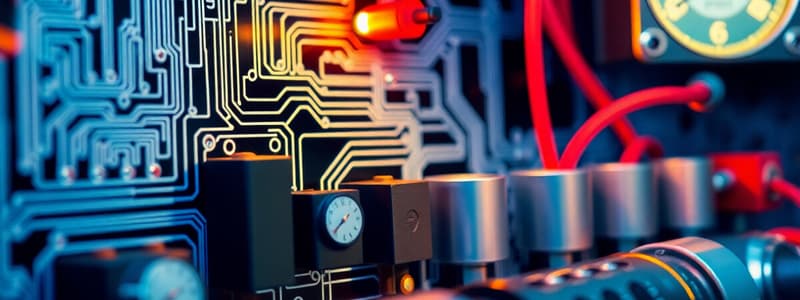Podcast
Questions and Answers
What operations do operational amplifiers (op-amps) typically perform in circuit design?
What operations do operational amplifiers (op-amps) typically perform in circuit design?
- Only filtering
- Only amplification
- Amplification, summing, filtering, and signal conditioning (correct)
- Only signal conditioning
Which formula represents the power dissipation in a resistor?
Which formula represents the power dissipation in a resistor?
- P = I²R (correct)
- P = VR
- P = R²/I
- P = IV
What is an essential characteristic of operational amplifiers that must be understood for effective circuit design?
What is an essential characteristic of operational amplifiers that must be understood for effective circuit design?
- Maximum current supply
- Input capacitance
- Frequency response
- Input impedance (correct)
Why is power analysis important in circuit design?
Why is power analysis important in circuit design?
What is the main benefit of using circuit simulation software?
What is the main benefit of using circuit simulation software?
What is the primary goal of circuit analysis?
What is the primary goal of circuit analysis?
Which law states that the sum of currents entering a node equals the sum of currents leaving that node?
Which law states that the sum of currents entering a node equals the sum of currents leaving that node?
What is the unit of resistance for resistors?
What is the unit of resistance for resistors?
Which method is based on Kirchhoff's Voltage Law?
Which method is based on Kirchhoff's Voltage Law?
Impedance in AC circuits is a combination of which components?
Impedance in AC circuits is a combination of which components?
What does superposition theorem allow you to do?
What does superposition theorem allow you to do?
What characterizes the transient behavior of a circuit?
What characterizes the transient behavior of a circuit?
Which component opposes changes in current?
Which component opposes changes in current?
Flashcards
Circuit Analysis
Circuit Analysis
The process of determining the behavior of electrical circuits by applying fundamental principles of electricity to analyze components and their interactions.
Ohm's Law
Ohm's Law
A fundamental relationship between voltage (V), current (I), and resistance (R) in a circuit, expressed as: V = IR.
Capacitor
Capacitor
An electronic component that stores electrical energy in an electric field. It opposes changes in voltage.
Inductor
Inductor
Signup and view all the flashcards
Nodal Analysis
Nodal Analysis
Signup and view all the flashcards
Mesh Analysis
Mesh Analysis
Signup and view all the flashcards
Superposition Theorem
Superposition Theorem
Signup and view all the flashcards
Impedance (Z)
Impedance (Z)
Signup and view all the flashcards
Op-Amp
Op-Amp
Signup and view all the flashcards
Power Dissipation
Power Dissipation
Signup and view all the flashcards
Power Dissipation in a Resistor
Power Dissipation in a Resistor
Signup and view all the flashcards
Circuit Simulation
Circuit Simulation
Signup and view all the flashcards
LTspice, PSpice
LTspice, PSpice
Signup and view all the flashcards
Study Notes
Introduction to Circuit Analysis
- Circuit analysis determines the behavior of electrical circuits.
- It applies fundamental electrical principles to analyze circuit components and their interactions.
- The goal is predicting voltage, current, and power at different circuit points.
- Methods include nodal analysis, mesh analysis, and superposition.
Basic Circuit Elements
- Resistors oppose current flow; resistance is in ohms (Ω). Ohm's law (V = IR) relates voltage (V), current (I), and resistance (R).
- Capacitors store energy in an electric field; capacitance is in farads (F). Capacitors resist voltage changes.
- Inductors store energy in a magnetic field; inductance is measured in henries (H). Inductors resist current changes.
- Voltage sources provide constant voltage.
- Current sources provide constant current.
Circuit Analysis Techniques
- Nodal Analysis: System of equations based on Kirchhoff's Current Law (KCL). KCL states that current entering a node equals current leaving.
- Mesh Analysis: Based on Kirchhoff's Voltage Law (KVL). KVL states that the sum of voltage drops around a closed loop is zero.
- Superposition Theorem: Analyze each independent source individually, then sum results for the total circuit response.
AC Circuit Analysis
- AC circuits involve sinusoidal current and voltage.
- Impedance (Z) is complex opposition to AC current flow.
- Impedance depends on resistance (R), capacitive reactance (Xc), and inductive reactance (Xl).
- Frequency significantly affects AC circuit behavior.
- Resonance and phasor diagrams are important concepts.
Transient Analysis
- Transient analysis describes circuit behavior when voltage or current changes suddenly.
- Transient behavior is characterized by time constants, dependent on circuit components.
- Time constants indicate the rate of reaching steady-state response after a change.
- Crucial for understanding circuit response to step inputs or other transient events.
Operational Amplifiers (Op-Amps)
- Op-amps are high-gain differential amplifiers.
- Essential in analog circuit design.
- Used for amplification, summing, filtering, and signal conditioning.
- Understanding op-amp characteristics (input impedance, output impedance, gain) is essential.
Power Analysis
- Power dissipation in circuit elements is crucial.
- Power (P) is measured in watts (W).
- Resistor power dissipation: P = I²R = V²/R.
- Power analysis ensures components don't overheat.
Circuit Simulation
- Software tools simulate circuit behavior before physical construction.
- Common tools include LTspice, PSpice, and others.
- Simulation reduces time and cost for physical prototyping.
Studying That Suits You
Use AI to generate personalized quizzes and flashcards to suit your learning preferences.




